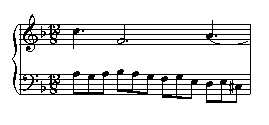Canon alla Decima in contrapunto alla Terza
José Rodríguez Alvira
The Canon alla Decima in contrapunto alla Terza is an excellent example of the use of the inversion at the tenth technique. If you need help understanding the contrapuntal inversion technique read Invertible Counterpoint.
This canon begins with a 4 measure subject or theme:

This subject is based on the original subject transformed by contrary motion or inversion (ascending intervals become descending intervals and vice versa). In the following image we compare both subjects:

In measure 5 the second voice answers the bass at the tenth or third:

The upper voice follows the lower voice until measure 40, where it presents the subject:

Yet there are some interesting details before measure 40. Measures 5 to 8 are inverted at the tenth in measures 9 to 11:

As in the canon at the twelve, Bach repeats measures 5 to 39 but inverting the voices at the tenth:

The canon ends with a small coda in measures 79 to 82. A short summary of the structure:
| Measures | |
|---|---|
| 1 - 39 | Lower voice is imitated at the tenth |
| 40 - 78 | The subject reappears in the upper voice while the lower voice begins imitating the upper voice using the inversion at the tenth |
| 76 - 78 | Coda |
Listen to the complete canon. We have highlighted the imitations using numbers. For example, the subject is labeled as 1 and when imitated by the upper voice, the upper voice imitation will be labeled as 1. We also show the intervals between voices:
Invertible counterpoint in the canon at the tenth
As you can see in the inversion table at your right, the inversion at the tenth presents a lot of problems. The most useful intervals - thirds and sixths - invert as octaves and fifths. This means that if you use parallel thirds or sixths you will get parallel octaves and fifths after inversion. Also, if you use a lot of thirds or sixths you will get a lot of octaves and fifths after the inversion and your counterpoint will probably sound too consonant and uninteresting.
Inversion at the tenth table
| 2 | 3 | 4 | 5 | 6 | 7 | 8 | 9 |
| 9 | 8 | 7 | 6 | 5 | 4 | 3 | 2 |
When we analyze the counterpoint in this canon we find that Bach:
- Uses contrary motion whenever thirds or sixths are used to avoid parallel octaves and fifths.
- Makes a balanced use of imperfect consonances (thirds or sixths) and perfect consonances (octaves and fifths)
Recordings: